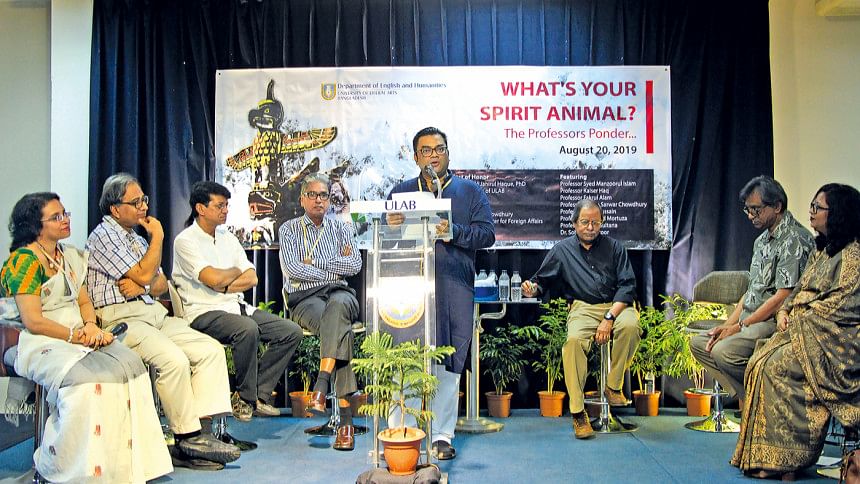Searching for One’s Spirit Animal

What is your totem animal?
Or, What Animal Are You?
Many of us have often taken similar tests online. The native Americans believe that from birth to death, there is this animal that guides one through thick and thin. But seriously, do we ever really consider what animal guides us through our lifetime? Are we comfortable talking about that animal hiding under our skins? Some of us can quite casually claim our animal spirits while some keep stonily silent, or flinch uncomfortably while talking about it. It is indeed an interesting notion—learning to understand one's animal spirit, especially at a time when the world looks on animalistic ways as negative.

At ULAB, this past August, some of the most acclaimed academics of English in Bangladesh engaged in talking about their totems. Eight faculty members associated with the Department of English & Humanities at ULAB, unfolded an amazing array of animal spirits and made the audience ponder over their respective spiritual guides.
The program began with the youngest among the faculty members on stage, who also happens to be this poor editor (somehow got entangled with these majestic creatures), who waddled her way from the pond to the stage and explained how she identifies with the duck as her spirit animal. A duck is a funny creature, and nobody can resist a smile at the sound emitting from its beaks. Ducks are humble, but they also teach one not to take oneself too seriously. It's necessary to laugh and love in life, and therefore, who can introduce the spirit animals better than a duck?

Next in line was Prof. Shaila Sultana of IML. Currently, she is also the Advisor of the Centre for Language Studies (CLS) at ULAB. Clad in a brown saree, she claimed bear as her spirit animal and explained how with a brown skin and mask she identifies herself as a postcolonial being. Dr. Sultana mentioned the legendary King Arthur and how his name and the bear's bear the same root word "artos." She also brought in the story of Teddy Bear and its association with the American President Theodore Roosevelt. She went back to the ancient Shamanic practices that often involved bears. Most importantly, she explored the different aspects of the nature of the bear and how it affects her role of a wife, mother, elder sister, teacher and colleague. Dr. Sultana concluded from all the interpretations that when post humanistic discourses aim to explore the subjective understandings of real experiences beyond the boundaries of our distance engagement and understanding of different faculties, the presence of different totem animals become our guiding spirit.

Prof. Shamsad Mortuza, currently on leave from the Department of English at DU, and the Pro Vice Chancellor of ULAB, explained how the figure of the trickster took over at different crucial points of his life and how he survived and flourished. He started his speech by defining humans with reference to Shakespeare's definition of man—"the beauty of the world, the paragon of man." Shakespeare indeed taught us the art of being human in the humanities. In a half humorous and half serious manner, Prof. Mortuza went on to elucidate how we want to hide our animal selves and become either god or angel. He explained how the trickster is a shape-shifter like Loki or Prometheus. He quoted from The American Indian Trickster Tales describing the characteristics of a trickster: "the tricksters are always hungry for another meal swiped from someone else's kitchen, always trying to get something for nothing, shifting shapes (and even sex), getting caught in the act, always ready to lure someone else's wife to bed, ever scheming and never remorseful." As literary examples, he referred to Volpone, Reynard the fox, Puck and Ariel. He brought in the world of Swift's humans and horses showing how humans and animals are interchangeable. In the old world, the trickster was the humanized animal like our shiyal mama. In the new world, the tricksters keep on shifting identities- between human and animals.
Recalling his days as a graduate student, Dr. Mortuza narrated how he chose trickster as his research topic and learnt to survive through the politics of the academia. These days however, he has engaged his shamanic talents in creating space for amazing creative and academic events at ULAB, and thus rendering it as one of the most happening universities in Bangladesh.

A classic orator, Prof. Azfar Hussain started his speech by asking, "So, what animal am I? He picked the brains of his audience before finally letting the cat out of the bag. His presentation on his totem animal was witty and hilarious with words like, "purr-fect," "purr-ple," "catti-tudes," "cat logical" and "meow-ment." He recited lines from Jibananda Das's "Beral," and poems by T. S. Eliot and Pablo Neruda. He reminded how cats have nine lives and hence symbolize rebirth and resurrection. They also represent independence, curiosity, mystery and magic. Cats exist in most ancient mythologies. They are indeed favorite creatures of many writers and authors. Listing various aspects of cats, Prof. Hussain finally turned to a parody of his own poem, entitled, "My Version of Meowism," ending each line with repeated "meows" and evoking the audience to meow with him. The entire hall erupted with meows at the end of his speech. The audience laughed, danced and repeated after him and he finished with huge applause from the audience. His session was the most interactive one, spectacular and full of fun.

Prof. Golam Sarwar Chowdhury narrated the story of a dog during the Liberation War of Bangladesh. He was living in the port city of Chittagong at his father's place along with his siblings. There was a dog of Sarail breed at their house called Mita (meaning friend in Bengali). Prof. Chowdhury went on to tell a moving story of the terrifying days of '71 and how they listened to the Swadhin Bangla Betar Kendra. In mid-December, around the time of the Pakistani Army's surrender, two members of the Pakistani Army came to their house and knocked hard. They had come to take a last-minute revenge on the local people, but they were attacked by Mita who lunged on one of the solders. The soldier opened fire and the managed to injure his companion. The War ended soon but the spirit of the dog remains to remind that an animal has a lot to teach, especially in a world that has lost its values and judgment. The veteran Professor mused rather sadly what the human world signifies when vendetta and arrogance have replaced friendship and loyalty.

Prof. Fakrul Alam opened up and spoke of his interpretation of the guiding spirit. He started by welcoming guests and old friends. Then he playfully asked, "How does Shamsad come up with these ideas?" Before finally addressing his totem animal, he toyed with the choices of his teammates. He found little similarities between his student Sohana and a duck. And Shaila, who claimed to be a bear, did not talk about bear hugging. However, he agreed that Shamsad Mortuza is indeed a trickster, who is armed with all kinds of tricks and is always looking for different ways of engaging his fellow colleagues in intellectual fun feats. He mentioned coyote—a trickster symbol of effortless adaptability with his mind always working. He appreciated dogs presented by Prof. Sarwar Chowdhury but wistfully mentioned a few cats Azfar Hussain had left out. Finally, he came to his totem animal whale represented through Melville's gigantic novel, Moby Dick.
Dr. Alam had harpooned Moby Dick for two decades at the Dhaka University until the book was finally taken out of the syllabus due to its sheer volume. But for him Moby Dick is an encyclopaedia of vastness. He said somewhat regretfully that once upon a time the whale was the King of the boundless sea with a profound connection to cosmic consciousness. But now, if one googles the term "whale," it yields results like "whale is endangered…" But of course, the Professor who always had words of hope for his students, could not end on a despondent note. He hopes that some student will still read Melville's massive novel and learn to love what whales represent.

After Dr. Fakrul Alam, Professor Kaiser began with his characteristically brilliant puns and greeted the audience with the distinct sound of an animal. He insisted that the audience greeted him back the same way, which ultimately led to the entire auditorium hilariously hissing to each other, giving away the name of the animal he would be talking about that day- snakes. He then went on to explain how the snake is an ancient creature which has been there in almost every culture since the evolution of time. Referring to the primordial fear of the animal, he noted that the same fear makes us revere the snake, making it a primeval presence in our myths and stories. In Bangladeshi culture, tales of Chand Soudagar, Manasa Devi or Behula, one of the "most fascinating folk narratives to emerge from the eastern part of the subcontinent," are told and retold many times in many ways.
Prof. Haq then elaborated on how Bangladesh is the core of all the different versions of Manasa that are available out there which have not been transcribed yet. He proceeded to talk about his experience while working on the English prose version of Manasa stories namely, The Triumph of the Snake Goddess (2015), a composite of eight different variants of the original folktale, only one of its kind in any language as of now. While on it, he spoke about how the Manasa myths are still a living tradition as in one of his visits to a manasa festival in Tangail, he saw village drama groups performing rituals and palas based on the tale. Though the orthodox attitude towards the goddess has not changed over time, he asserted that unlike other old divinities, the snake devi herself is not so simple as she constantly changes her personality- "vindictive, charming, flirtatious, seductive, and generous" all in the blink of an eye, seeking constant acknowledgement and appreciation.
After that, he broke down the story of Chand Soudagar and Manasa, "the subaltern goddess." In the stories, Chand Soudagar, a man whose primary purpose is to make profit, refuses to acknowledge the devi, and thus the audience is brought to witness a clear clash of interests between the tradesman's naked profit motif and the goddess's desire to create a fused and organic society where everyone lives and let the others live. And to point out the revival of the story at the most crucial points of history, Professor Haq talked about the rise of the seventeenth century drought in Bengal, where the myth of a certain arrogant and power-driven Bortuki Saudagar became very popular, who defied the goddess, wanted to make profit for his own, boarded a ship, was chased by her, got enslaved, had his entire family murdered at the bites of numerous serpents and scorpions, and travelled half of the world only to find himself back at the feet of the goddess and build a shrine dedicated to her at the Sundarbans. Professor Haq ended his speech by jokingly alarming us that the idea of Manasa devi herself or her shrine for that matter migrating to one of those islands might not be that far-fetched either, since the migrants will take her stories along with their cultural belongings as they leave.

Syed Manzoorul Islam expressed his deepest sympathy for the marginalized and underrated creature called the bat. He started by reminiscing how back in the school one of his teachers used to call the students chamchikas; "Ore chamchike, toder ki korbo!" (Oh, little bats, what will I do with you!) Since then, said Prof. Islam, he came to learn about the negative impressions almost everyone used to hold against this harmless species in our community. He then proceeded to enumerate the interesting details he gathered together after much investigation with a view to debunking some popular myths about bats being vicious and blood-sucking monsters. He asserted that born with some uncanny perceptions, they cannot be fooled with disguise, and on top of it, they are super social animals as opposed to what we think them to be.
"As a teacher I have always aspired to be a communicator myself, and bats could teach us exactly that," confirmed the respected professor. "Who knows how to change the direction of a conversation when necessary and adapt on a dime when situation calls for it?" he asked the audience.
After sorting out the little-known intriguing details he found on bats, he elaborated the presence of bats as found in literature. Starting with Shakespeare's Macbeth, for example, he reminded us of the witches' broth that had a "wool-of-bat" in it, implying how bats in Shakespeare's time were associated with witchcraft and terror- all negative. Bats are easy to find in the ancient Anglo-Saxon stories as well. Dr. Islam further mentioned Titania's narrative from A Midsummer Night's Dream and John Keats' sonnet called "Before He Went to Live with Owls and Bats" which is about Nebuchadnezzar II, the Babylonean king.
The second reason behind choosing bats as his spirit animal of the day, in Dr. Islam's words, has to do with the particular pattern of life a bat lives which strikingly resonates with his reading of postcolonial/post-modern literature and also the issues that one has to deal with every day. When considered from a postcolonial (or that of ecocriticism) point of view, Dr. Islam stressed it is only logical to see bats as the ultimate "exotic/demonic other" in the animal kingdom with the common attitude towards them being one of fear and disgust, much similar to the idea of subaltern identities completely denied under a veil of generalized description.
If illustrated as a postcolonial truth in the making, it cannot be denied how the west views the bat in its normal perceptions as something which is evil where the east likes to present a different picture. According to Professor Islam, the truth lies somewhere in between against the modern paranoia of hanging upside down, since it connotes a postmodern rejection of the rigid modern order and structure. Finally, he ends his highly informative speech by sharing his preference for a "mega bat" among all other bats, followed by a loud round of applause.
The innovative Animal Spirit event took place on a Tuesday afternoon (middle of the week) and yet the hall was full and people were thoroughly enthused and expectant. The program was over in about two hours, and the audience went away wondering and pondering over their respective animal spirits. Did they glimpse the shadows of their inner spirits over their shoulders? I thought I saw a few horns, shaggy manes and bushy tails. But then the approaching evening was causing all kinds of tricks with the lights. Maybe it was just a figment of my imagination.
Sohana Manzoor is Associate Professor, Department of English & Humanities at ULAB. She is also the Editor of the Star Literature & Reviews Pages.

 For all latest news, follow The Daily Star's Google News channel.
For all latest news, follow The Daily Star's Google News channel. 



Comments